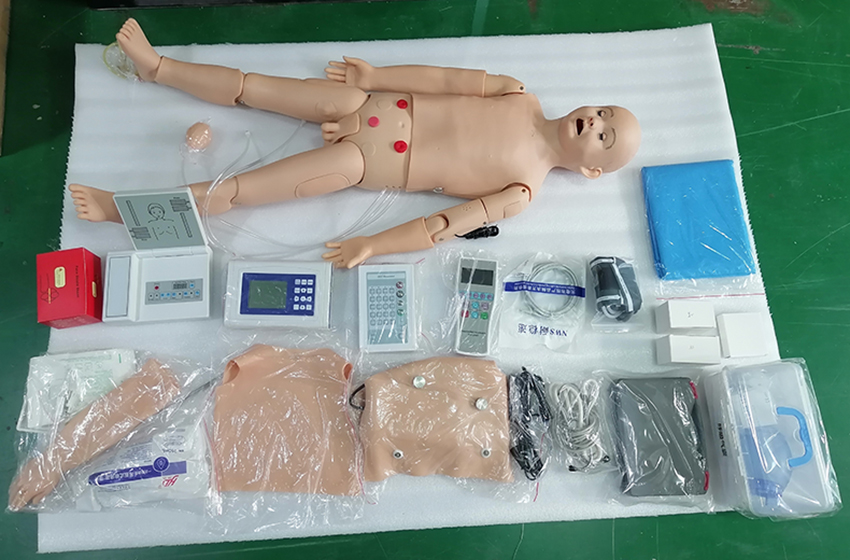
7、Evacuate the sleeve with a syringe and pull out the catheter.
Three.Intravenous injection
Arm intravenous injection operation method
Installation method:
Put two rubber tube clamps into the two rubber tubes connected with the plastic upper limb model, one rubber tube up and through the connecting sleeve with the blood simulation fluid (Note: At the beginning, use water first, and then use the blood simulation fluid after getting familiar with it. Blood simulation fluid preparation method: it is recommended to use simulated blood powder 4 grams plus 100 ml of water preparation) of the infusion bag (bottle) connected. The other rubber tube is downward and inserted into the waste fluid bottle.
Arm vein puncture blood drawing, intravenous injection or intravenous infusion, intravenous blood transfusion training program:
1, through the elbow forearm vein puncture blood drawing
Venous phlebotomy operation training:
Step 1 200-300 ml of blood simulation fluid and plastic upper limb model of the upper position of the rubber tube
Connect 200-300 ml of blood simulating fluid with the upper rubber tube of the plastic upper limb model, so that the blood simulating fluid is injected into and fills the pipeline system of the plastic upper limb model, and the lower rubber tube clamp is clamped to block the lower rubber tube.
Step 2 Routinely sterilize the skin of the elbow and forearm.
Step 3 Select a suitable vein, puncture the vein with a 10-mL syringe, and draw 2 mL of venous blood (blood simulator).
2 ml of vein blood (blood simulating solution).
Intravenous injection or intravenous infusion through the forearm of the elbow
Intravenous injection or intravenous infusion training:
Step 1 Same as step 1 for venous blood sampling via the elbow forearm, using a syringe tray, suitable syringe, 6-8 gauge needle, medication,
sandbag, sterile gloves and sterile therapeutic towel. This method of injection is contraindicated in patients with hematologic disorders as it may cause excessive bleeding.
Step 2 Routinely disinfect the skin of the elbow and forearm with sterile gloves and sterile cavity towel.
Step 3 Fix the selected vein with the index and middle fingers of the left hand, hold a syringe (50 ml syringe, No. 6-8 needle) with the liquid extracted in the other hand, puncture the vein vertically or at an angle of 40° with the vein, and when red liquid enters into the syringe by retracting the needle, clamp the upper rubber tubing clip in order to block the upper rubber tubing, release the lower rubber tubing clip, and fix the puncture needle with the other hand. Puncture needle, at the same time with the other hand as fast as possible to push the injection of liquid, so that the liquid in the syringe flow through the pipeline system in the model, so that the liquid through the lower rubber tube into the waste liquid bottle. Remove the needle quickly when the injection is complete. Intravenous infusion when stabbing the vein back to see the red liquid into the syringe, then loosen the upper rubber clamp, adjust the drip speed of the intravenous infusion device, so that the infusion bottle of red blood simulation liquid flow through the model of the piping system and through the lower rubber tube into the waste liquid bottle, fixed puncture needle.
3、Trans-elbow forearm venous blood transfusion
Intravenous blood transfusion operation training:
Step 1 is the same as step 1 of venous blood sampling through the forearm of the elbow.
Step 2 Routinely sterilize the skin of elbow forearm.
Step 3 Choose the suitable vein, puncture the vein with a syringe needle, pump back to see the red liquid into the venous transfusion device, adjust the drip speed, so that the red blood simulation liquid in the transfusion bottle flows through the pipeline system in the model and through the lower rubber tube into the waste liquid bottle.
IV. Bone marrow aspiration and intraosseous infusion
Bone marrow puncture training:
Step 1 Place the model on top of the table, apply lubricating powder to lubricate the entire bone marrow puncture components, mount and slide the right tibial bone marrow puncture components, from the sole of the foot upward, into a fixed position on the tibia of the lower leg, and cover the lower leg with a skin jacket.
Step 2 Place a disposable waterproof dust cloth pad that absorbs fluid under the knee joint of the model, and attach the adjustable infusion frame, infusion bag and its
Connect the adjustable infusion stand, the infusion bag and its connecting tubes to the tibial bone marrow puncture parts, install and adjust them to become ready for infusion, and remove air bubbles in the tubes (start the operation with the infusion bag in the first place).
When operating, use pure water in the infusion bag first, and then use blood simulation fluid after skillful operation. Preparation of blood simulating fluid: it is recommended to use
(simulated blood powder 4 grams plus 100 ml of water configuration).
Step 3 (1) Check that the tibial bone marrow puncture component is filled with fluid. Prevent leakage of blood simulating solution during the procedure.
(2) For bone marrow aspiration, a special bone marrow aspiration needle should be used. After anesthetizing the skin to the periosteum, slowly pressurize the bone marrow by using the forearm and the bone marrow aspiration needle as an axis and turning it back to prevent excessive pressure, so that simulated bone marrow fluid can flow out when the puncture is done correctly. The sample can be taken with a 5 ml syringe. Bone marrow fluid extraction is generally 0.1-0.2 ml, and 1-2 ml of bone marrow fluid can be extracted if used for bacterial culture. (3) The tibial bone marrow puncture component is designed to puncture on all four sides, and the bone marrow puncture operation is followed by sealing the hole in the bone with a small piece of wax. After one side of the puncture component has been punctured, the component can be rotated 90° and reinserted into the tibia until all four sides of the tibial bone marrow puncture component have been punctured, at which point the component can be discarded.
Intraosseous Infusion:
Intraosseous Infusion (IOI): is the introduction of fluids, blood, or medications directly into the bone marrow of the tibia or into other bones. Intraosseous infusion is an ancient technology, in the clinical application of infant shock resuscitation, it has the characteristics of fast, simple, safe and effective, especially for the patients who can not establish the vascular access during the first aid (when severe dehydration, blood loss, peripheral veins can not be seen or touched, and can not establish the resuscitation channel). Intraosseous infusion is mostly used in the tibial position. Bone marrow aspiration in the right tibia of the simulator: Establishment of an inlet for intraosseous infusion requires asepsis. A bone marrow aspiration needle (16-gauge) is inserted 1 cm below the tibial tuberosity. Pressurization and back-and-forth rotation of the bone marrow aspiration needle penetrate 2-3 cm deep, and when the bone is penetrated into the bone cortex, there is a feeling of emptiness, and the core of the needle can be withdrawn to draw out the simulated bone marrow fluid with a syringe. The intraosseous inlet is connected to the intraosseous infusion channel with a needle connector, and the needle connector is clamped with hemostatic forceps and fixed to the leg. After stabilization, the intraosseous inlet can be used to inject fluids, blood, or drugs. It has been suggested in the literature that intraosseous infusions usually need to be performed for 1-2 hours until a safer venous access system has been established. Ensure that the tube is drained after each use. Use glue or sealant to close the needle hole after the intraosseous infusion puncture to prevent fluid leakage. The tibial module can also be inverted for puncture or replaced with a new tibial module.
V. Blood pressure measurement training (blood pressure measurement trainer)

Name: manager zheng
Mobile:0086-13588958091
Tel:0086-0577-62626932
Whatsapp:8613588958091
Email:sales@kangmugroup.com
Add:qiaoqian industrial zone, liushi wenzhou, zhejiang,325600,china
We chat
